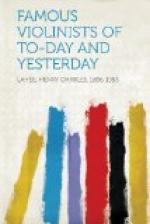“Then from one chord of his amazing
shell
Would he fetch out the voice of quires,
and weight
Of the built organ; or some twofold strain
Moving before him like some sweet-going
yoke,
Ride like an Eastern conqueror, round
whose state
Some light Morisco leaps with his guitar;
And ever and anon o’er these he’d
throw
Jets of small notes like pearl.”
CHAPTER V.
1800 To 1830.
Paganini was an epoch-making artist. He revolutionised the art of violin playing, and to his influence, or through his example, were developed the modern French and Belgian schools. While Paganini was a genius, a great musician, and a wonderful violinist, he combined with these qualities that of a trickster, and the exponents of the modern French school adopted some of the less commendable features of Paganini’s playing, while the Belgian school followed the more serious lines, and became a much sounder school.
Alard, Dancla, and Maurin were exponents of the French school, while in that of Belgium we have De Beriot, Massart, Vieuxtemps, Leonard, Wieniawski.
Lambert Joseph Massart was born at Liege in 1811, and was first taught by an amateur named Delavau, who, delighted with the remarkable talent displayed by his young pupil, succeeded in securing for him, from the municipal authorities of Liege, a scholarship which enabled him to go to Paris.
On his arrival at the Conservatoire, Cherubini, who was splenetive and rash, refused him admission without assigning any reason for his decision, but Rudolph Kreutzer took upon his shoulders the task of forming the future artist.
Notwithstanding Massart’s great talent and excellent capabilities as an artist, he never became a success as a concert player, because of his inordinate shyness, but as a teacher few have equalled him.
Sir Charles Halle, in his autobiography, tells a good anecdote concerning Massart’s shyness and modesty. Massart was to play, with Franz Liszt, a program which included the Kreutzer sonata. Just as the sonata was begun a voice from the audience called out “Robert le Diable,” referring to Liszt’s brilliant fantasia on themes from that opera, which he had recently composed, and had played several times with immense success. The call was taken up by other voices, and the sonata was drowned. Liszt rose and bowed, and presently, in response to the continued applause, he said: “I am always the humble servant of the public. But do you wish to hear the fantasia before or after the sonata?”
Renewed cries of “Robert” were the only reply, upon which Liszt turned half around to Massart and dismissed him with a wave of the hand, but without a word of excuse or apology. Liszt’s performance roused the audience to a perfect frenzy, but Massart nevertheless most dutifully returned and played the Kreutzer sonata, which fell entirely flat after the dazzling display of the great pianist.




